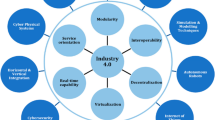Abstract
This research investigates through a systems approach, “Additive Manufacturing” (AM) applications in “Defence Support Services” (DS2). AM technology is gaining increasing interest by DS2 providers, given its ability of rapid, delocalised and flexible manufacturing. From a literature review and interviews with industrial and academic experts, it is apparent that there is a lack of research on AM applications in DS2. This paper’s contribution is represented by the following which has been validated extensively by industrial and academic experts: (1) DS2 current practices conceptual models, (2) a framework for AM implementation and (3) preliminary results of a next generation DS2 based on AM. To carry out the research, a Soft System Methodology was adopted. Results from the research increased the confidence of the disruptive potential of AM within the DS2 context. The main benefits outlined are (1) an increased support to the availability given a reduced response time, (2) reduced supply chain complexity given only supplies of raw materials such as powder and wire, (3) reduced platform inventory levels, providing more space and (4) reduced delivery time of the component as the AM can be located near to the point of use. Nevertheless, more research has to be carried out to quantify the benefits outlined. This requirement provides the basis for the future research work which consists in developing a software tool (based on the framework) for experimentation purpose which is able to dynamically simulate different scenarios and outline data on availability, cost and time of service delivered.






















Similar content being viewed by others
References
Apte A, Rendon R (2009) A diagnostic approach to weapon system lifecycle support: the phalanx close-in weapon system. Int J Def Acquis Manag 2:1–16
ASTM (2013) Standard terminology for additive manufacturing technologies (No. F2792-12a). ASTM Int
Busachi A, Erkoyuncu J, Colegrove P (2015a) A review of cost modelling of additive manufacturing for defence support services. J Manuf Sci Technol
Busachi A, Erkoyuncu J, Colegrove P, Martina F, Ding J (2015b) Designing a WAAM based manufacturing system for defence applications. Proc CIRP 37:48–53. doi:10.1016/j.procir.2015.08.085
Checkland PB (2001) Soft Systems Methodology. Rational analysis for a problematic world revisited. Wiley, Hoboken
Erkoyuncu et al (2015) Opportunities for additive manufacturing to address component obsolescence challenges. RAND Corporation, Santa Monica
Ivanova O, Williams C, Campbell T (2013) Additive manufacturing (AM) and nanotechnology: promises and challenges. Rapid Prototyp J 19:353–364. doi:10.1108/RPJ-12-2011-0127
Iwata C, Mavris D (2013) Object-oriented discrete event simulation modeling environment for aerospace vehicle maintenance and logistics process. Proc Comput Sci 16:187–196. doi:10.1016/j.procs.2013.01.020
Khajavi SH, Partanen J, Holmström J (2014) Additive manufacturing in the spare parts supply chain. Comput Ind 65:50–63. doi:10.1016/j.compind.2013.07.008
MBDA (2015) Missile systems, defence systems—MBDA missiles. (WWW Document). http://www.mbda-systems.com/. Accessed 12 June 2015
Pérès F, Noyes D (2006) Envisioning e-logistics developments: making spare parts in situ and on demand. Comput Ind 57:490–503. doi:10.1016/j.compind.2006.02.010
RAND (2013) Future technology landscapes. RAND Europe, Cambridge
REF (2015) REF rapid equipping force—United states army (WWW Document). http://www.ref.army.mil/. Accessed 12 June 2015
Robinson S (2004) Simulation: the practice of model development and use. Wiley, Hoboken
US Army, 2015. The official home page of the United States Army, The United States Army (WWW Document). http://www.army.mil/. Accessed 12 June 201515
Acknowledgement
The Authors thank Dr. Richard Drake and Dr. Chris Watts of Babcock International for their contribution. This research is performed within the EPSRC Centre for Innovative Manufacturing in Through-Life Engineering Services, Grant Number EP/1033246/1.
Author information
Authors and Affiliations
Corresponding author
Rights and permissions
About this article
Cite this article
Busachi, A., Erkoyuncu, J., Colegrove, P. et al. Additive manufacturing applications in Defence Support Services: current practices and framework for implementation. Int J Syst Assur Eng Manag 9, 657–674 (2018). https://doi.org/10.1007/s13198-017-0585-9
Received:
Revised:
Published:
Issue Date:
DOI: https://doi.org/10.1007/s13198-017-0585-9




